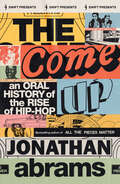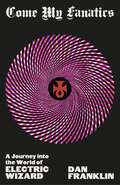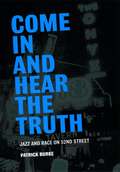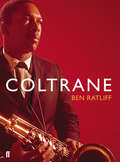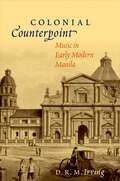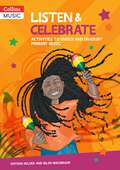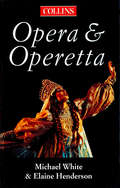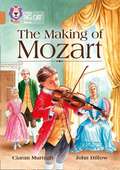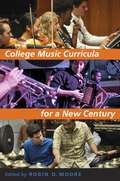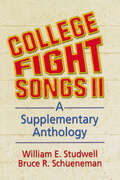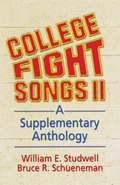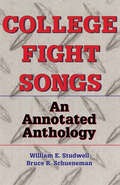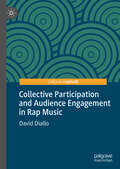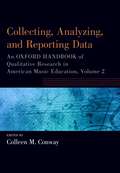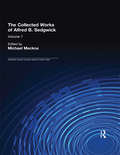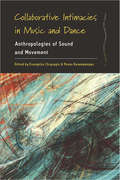- Table View
- List View
The Come Up: An Oral History of the Rise of Hip-Hop
by Jonathan AbramsThe music that would come to be known as hip-hop was born at a party in the Bronx in the summer of 1973. Now, fifty years later, it’s the most popular music genre in America. Just as jazz did in the first half of the twentieth century, hip-hop and its groundbreaking DJs and artists—nearly all of them people of colour from some of America’s most overlooked communities—pushed the boundaries of music to new frontiers, while transfixing the country’s youth and reshaping fashion, art, and even language. And yet, the stories of many hip-hop pioneers and their individual contributions in the pre-Internet days of mixtapes and word of mouth are rarely heard—and some are at risk of being lost forever. Now, in The Come Up, the New York Times bestselling author Jonathan Abrams offers the most comprehensive account so far of hip-hop’s rise, a multi-decade chronicle told in the voices of the people who made it happen. In more than three hundred interviews conducted over three years, Abrams has captured the stories of the DJs, executives, producers, and artists who both witnessed and themselves forged the history of hip-hop. Masterfully combining these voices into a seamless symphonic narrative, Abrams traces how the genre grew out of the resourcefulness of a neglected population in the South Bronx, and from there how it flowed into New York City’s other boroughs, and beyond—from electrifying live gatherings, then on to radio and vinyl, below to the Mason-Dixon Line, west to Los Angeles through gangster rap and G-funk, and then across generations. Abrams has on record Grandmaster Caz detailing hip-hop’s infancy, Edward “Duke Bootee” Fletcher describing the origins of “The Message,” DMC narrating his role in introducing hip-hop to the mainstream, Ice Cube recounting N.W.A’s breakthrough and breakup, Kool Moe Dee recalling his Grammys boycott, and countless more key players. Throughout, Abrams conveys with singular vividness the drive, the stakes, and the relentless creativity that ignited one of the greatest revolutions in modern music. The Come Up is an exhilarating behind-the-scenes account of how hip-hop came to rule the world—and an essential contribution to music history.
Come My Fanatics: A Journey into the World of Electric Wizard
by Dan Franklin'Electric Wizard is heavy, man - we don't sing about love and flowers.' Jus ObornIn 1993, in the market town of Wimborne Minster in Dorset, England, the heaviest band in the world was born. Led by guitarist and singer Jus Oborn, Electric Wizard began as an untameable power trio. They inhaled the iniquity of their lives and vomited it out in colossal waves of doom metal, synthesising the forbidding local landscape, biker culture, video-nasties, black magic rituals and titanic doses of psychedelics. In 1997 they released their revolutionary second album, Come My Fanatics... Then, after triumphant and calamitous tours of the USA and following the release of arguably the heaviest rock album ever recorded, 2000's Dopethrone, Electric Wizard all but imploded, destroyed by the very reality they were fighting against. However, when guitarist Liz Buckingham joined Oborn on guitar for We Live, they drew a magic circle around themselves in a new line-up that went on to explore deeper occult horrors on modern doom classic Witchcult Today onwards. Come My Fanatics is a kaleidoscopic exploration of the subculture the band has absorbed and, in turn, created. From seventies exploitation cinema, through the writers of Weird Tales magazine and a panoply of the marginal and downright sinister, to the band's own live ceremonial happenings - this is Electric Wizard's world. We're just dying in it.
Come In and Hear the Truth: Jazz and Race on 52nd Street
by Patrick BurkeBetween the mid-1930s and the late ’40s, the center of the jazz world was a two-block stretch of 52nd Street in Manhattan. Dozens of crowded basement clubs between Fifth and Seventh avenues played host to legends such as Billie Holiday and Charlie Parker, as well as to innumerable professional musicians whose names aren’t quite so well known. Together, these musicians and their audiences defied the traditional border between serious art and commercial entertainment—and between the races, as 52nd Street was home to some of the first nightclubs in New York to allow racially integrated bands and audiences. Patrick Burke argues that the jazz played on 52nd Street complicated simplistic distinctions between musical styles such as Dixieland, swing, and bebop. And since these styles were defined along racial lines, the music was itself a powerful challenge to racist ideology. Come In and Hear the Truth uses a range of materials, from classic photographs to original interviews with musicians, to bring the street’s vibrant history to life and to shed new light on the interracial contacts and collaborations it generated.
Coltrane: The Story of a Sound
by Ben RatliffNo other jazz musician has proved so inspirational and so fascinating as Coltrane. Ben Ratliff, jazz critic for the New York Times, has written the first book to do justice to this great and controversial music pioneer. As well as an elegant narrative of Coltrane's life Ratliff does something incredibly valuable - he writes about the saxophonist's unique sound.
Colonial Counterpoint: Music in Early Modern Manila (Currents in Latin American and Iberian Music)
by D. R. IrvingNamed one of BBC History Magazine's "Books of the Year" in 2010 In this groundbreaking study, D. R. M. Irving reconnects the Philippines to current musicological discourse on the early modern Hispanic world. For some two and a half centuries, the Philippine Islands were firmly interlinked to Latin America and Spain through transoceanic relationships of politics, religion, trade, and culture. The city of Manila, founded in 1571, represented a vital intercultural nexus and a significant conduit for the regional diffusion of Western music. Within its ethnically diverse society, imported and local musics played a crucial role in the establishment of ecclesiastical hierarchies in the Philippines and in propelling the work of Roman Catholic missionaries in neighboring territories. Manila's religious institutions resounded with sumptuous vocal and instrumental performances, while an annual calendar of festivities brought together many musical traditions of the indigenous and immigrant populations in complex forms of artistic interaction and opposition. Multiple styles and genres coexisted according to strict regulations enforced by state and ecclesiastical authorities, and Irving uses the metaphors of European counterpoint and enharmony to critique musical practices within the colonial milieu. He argues that the introduction and institutionalization of counterpoint acted as a powerful agent of colonialism throughout the Philippine Archipelago, and that contrapuntal structures were reflected in the social and cultural reorganization of Filipino communities under Spanish rule. He also contends that the active appropriation of music and dance by the indigenous population constituted a significant contribution to the process of hispanization. Sustained "enharmonic engagement" between Filipinos and Spaniards led to the synthesis of hybrid, syncretic genres and the emergence of performance styles that could contest and subvert hegemony. Throwing new light on a virtually unknown area of music history, this book contributes to current understanding of the globalization of music, and repositions the Philippines at the frontiers of research into early modern intercultural exchange.
Colonial Counterpoint: Music in Early Modern Manila (Currents in Latin American and Iberian Music)
by D. R. IrvingNamed one of BBC History Magazine's "Books of the Year" in 2010 In this groundbreaking study, D. R. M. Irving reconnects the Philippines to current musicological discourse on the early modern Hispanic world. For some two and a half centuries, the Philippine Islands were firmly interlinked to Latin America and Spain through transoceanic relationships of politics, religion, trade, and culture. The city of Manila, founded in 1571, represented a vital intercultural nexus and a significant conduit for the regional diffusion of Western music. Within its ethnically diverse society, imported and local musics played a crucial role in the establishment of ecclesiastical hierarchies in the Philippines and in propelling the work of Roman Catholic missionaries in neighboring territories. Manila's religious institutions resounded with sumptuous vocal and instrumental performances, while an annual calendar of festivities brought together many musical traditions of the indigenous and immigrant populations in complex forms of artistic interaction and opposition. Multiple styles and genres coexisted according to strict regulations enforced by state and ecclesiastical authorities, and Irving uses the metaphors of European counterpoint and enharmony to critique musical practices within the colonial milieu. He argues that the introduction and institutionalization of counterpoint acted as a powerful agent of colonialism throughout the Philippine Archipelago, and that contrapuntal structures were reflected in the social and cultural reorganization of Filipino communities under Spanish rule. He also contends that the active appropriation of music and dance by the indigenous population constituted a significant contribution to the process of hispanization. Sustained "enharmonic engagement" between Filipinos and Spaniards led to the synthesis of hybrid, syncretic genres and the emergence of performance styles that could contest and subvert hegemony. Throwing new light on a virtually unknown area of music history, this book contributes to current understanding of the globalization of music, and repositions the Philippines at the frontiers of research into early modern intercultural exchange.
Collins Primary Music Listen And Celebrate: Activities To Enrich And Diversify Primary Music
by Nathan Holder Helen MacGregor Charity RussellListen and celebrate introduces a selection of 15 pieces from a range of time periods, countries and styles, celebrating the people who wrote the music and offering an immersive experience through active listening and composing activities. As well as supporting National Curriculum objectives for Key Stages 1 and 2, this book will help bring breadth and depth to children's musical experience and understanding, offering a glimpse of the huge variety of music in the world and featuring composers from a range of backgrounds and experiences.
The Collins Guide To Opera And Operetta
by Michael White Elaine HendersonOriginally published in 1997, Collins Opera & Operetta is an invaluable guide to this fascinating but sometimes misunderstood art form, presenting essential information on over 180 major operas and operettas in an accessible, yet scholarly, way.
Collins Big Cat, Band 12, Copper: The Making of Mozart (PDF)
by Ciaran Murtagh Collins Big Cat StaffGet ready to meet a small boy with a big talent! Wolfgang Amadeus Mozart was composing music and travelling the world to perform for kings and emperors when he was only eight years old. This is his story. * Copper/Band 12 books provide more complex plots and longer chapters that develop reading stamina. * Text type - An information book. * The book is organised into short chapters to help children practise the skills of locating and identifying important information. * The glossary and index on pages 28 and 29 can be used to develop children's information retrieval skills further. * Curriculum links - Music
COLLEGE MUSIC CURRICULA FOR A NEW CENT C
by Robin D. MooreCritiques and calls for reform have existed for decades within music education, but few publications have offered concrete suggestions as to how things might be done differently. Motivated by a desire to do just that, College Music Curricula for a New Century considers what a more inclusive, dynamic, and socially engaged curriculum of musical study might look like in universities. Editor Robin Moore creates a dialogue among faculty, administrators, and students about what the future of college music instruction should be and how teachers, institutions, and organizations can transition to new paradigms. Including contributions from leading figures in ethnomusicology, music education, theory/composition, professional performance, and administration, College Music Curricula for a New Century addresses college-level curriculum reform, focusing primarily on performance and music education degrees, and offer ideas and examples for a more inclusive, dynamic, and socially engaged curriculum of applied musical study. This book will appeal to thoughtful faculty looking for direction on how to enact reform, to graduate students with investment in shaping future music curricula, and to administrators who know change is on the horizon and seek wisdom and practical advice for implementing change. College Music Curricula for a New Century reaches far beyond any musical subdiscipline and addresses issues pertinent to all areas of music study.
College Music Curricula for a New Century
Critiques and calls for reform have existed for decades within music education, but few publications have offered concrete suggestions as to how things might be done differently. Motivated by a desire to do just that, College Music Curricula for a New Century considers what a more inclusive, dynamic, and socially engaged curriculum of musical study might look like in universities. Editor Robin Moore creates a dialogue among faculty, administrators, and students about what the future of college music instruction should be and how teachers, institutions, and organizations can transition to new paradigms. Including contributions from leading figures in ethnomusicology, music education, theory/composition, professional performance, and administration, College Music Curricula for a New Century addresses college-level curriculum reform, focusing primarily on performance and music education degrees, and offer ideas and examples for a more inclusive, dynamic, and socially engaged curriculum of applied musical study. This book will appeal to thoughtful faculty looking for direction on how to enact reform, to graduate students with investment in shaping future music curricula, and to administrators who know change is on the horizon and seek wisdom and practical advice for implementing change. College Music Curricula for a New Century reaches far beyond any musical subdiscipline and addresses issues pertinent to all areas of music study.
College Fight Songs II: A Supplementary Anthology
by William E Studwell Bruce R SchuenemanCome join the band! College Fight Songs II is a supplement to the original College Fight Songs, providing 97 additional song texts and interesting historical information. Together they are a unique anthology of college fight songs from across the country.College Fight Songs II: A Supplementary Anthology is a second-round knockout that finishes the job started by the first edition. This rollicking continuation of the original collection will give you even more to shout about, again bringing together complete lyrics, historical annotations, and musical scores of the songs of over 50 more colleges and universities!Full of spirited music and lyrics that will put a spring in the step of incoming freshmen and music historians alike, College Fight Songs II is for you! You'll uncover plenty of behind-the-scenes info about the songs and the people who inspired them, and of course you'll find: complete musical scores full lyrics basic historical background concerning the songs and their institutions information regarding the songwriters and college nicknamesSo let&’s “Hail West Virginia,” stay “Ever True to Brown,” “Fight for LSU,” and shout out “The Buckeye Battle Cry!” College Fight Songs II will keep you in the game!
College Fight Songs II: A Supplementary Anthology
by William E Studwell Bruce R SchuenemanCome join the band! College Fight Songs II is a supplement to the original College Fight Songs, providing 97 additional song texts and interesting historical information. Together they are a unique anthology of college fight songs from across the country.College Fight Songs II: A Supplementary Anthology is a second-round knockout that finishes the job started by the first edition. This rollicking continuation of the original collection will give you even more to shout about, again bringing together complete lyrics, historical annotations, and musical scores of the songs of over 50 more colleges and universities!Full of spirited music and lyrics that will put a spring in the step of incoming freshmen and music historians alike, College Fight Songs II is for you! You'll uncover plenty of behind-the-scenes info about the songs and the people who inspired them, and of course you'll find: complete musical scores full lyrics basic historical background concerning the songs and their institutions information regarding the songwriters and college nicknamesSo let&’s “Hail West Virginia,” stay “Ever True to Brown,” “Fight for LSU,” and shout out “The Buckeye Battle Cry!” College Fight Songs II will keep you in the game!
College Fight Songs: An Annotated Anthology
by William E Studwell Bruce R SchuenemanGo, team, go! Rah, rah, rah! Boomalacka, boomalacka! Sis-boom-bah! Get your pennants and varsity colors and head for the stadium because College Fight Songs will make you an expert on the musical history of university athletic themes and anthems before the second-half kickoff. Here, in one anthology, you’ll find a unique collection of musical and historical information that hasn’t been compiled and updated since the days of Knute Rockne and the Galloping Ghost. This smart and spirited collection will give you plenty to rise and shout about, bringing together the complete lyrics, brief historical annotations, and musical scores for the songs of over 100 of the country’s most recognized colleges and universities.If you’re a researcher, librarian, musical enthusiast, band leader, musical historian, old-timer from way back when, or a young underclassmen interested in preserving a few cherished notes of your school’s history, College Fight Songs is the book for you. You’ll find plenty of hard-to-find facts about the songs and the people who inspired them, and you’ll get specific information in these areas: complete musical scores of college fight songs full lyrics of college fight songs basic historical background concerning the songs and their institutions information regarding the song creators and the college nicknamesSo, swing on the Rambling Wreck from Georgia Tech, rally around the bonfire and give a holler for the Buckeyes, the Wildcats, the Sooners, the Boilermakers, and the Tigers! The Gipper, the Bear, and Johnny U await you in this fabulous compendium of nostalgia and musical scores. Even after a few pages, College Fight Songs will have you hailing your alma mater and jumping in the car to head for the hop.
College Fight Songs: An Annotated Anthology
by William E Studwell Bruce R SchuenemanGo, team, go! Rah, rah, rah! Boomalacka, boomalacka! Sis-boom-bah! Get your pennants and varsity colors and head for the stadium because College Fight Songs will make you an expert on the musical history of university athletic themes and anthems before the second-half kickoff. Here, in one anthology, you’ll find a unique collection of musical and historical information that hasn’t been compiled and updated since the days of Knute Rockne and the Galloping Ghost. This smart and spirited collection will give you plenty to rise and shout about, bringing together the complete lyrics, brief historical annotations, and musical scores for the songs of over 100 of the country’s most recognized colleges and universities.If you’re a researcher, librarian, musical enthusiast, band leader, musical historian, old-timer from way back when, or a young underclassmen interested in preserving a few cherished notes of your school’s history, College Fight Songs is the book for you. You’ll find plenty of hard-to-find facts about the songs and the people who inspired them, and you’ll get specific information in these areas: complete musical scores of college fight songs full lyrics of college fight songs basic historical background concerning the songs and their institutions information regarding the song creators and the college nicknamesSo, swing on the Rambling Wreck from Georgia Tech, rally around the bonfire and give a holler for the Buckeyes, the Wildcats, the Sooners, the Boilermakers, and the Tigers! The Gipper, the Bear, and Johnny U await you in this fabulous compendium of nostalgia and musical scores. Even after a few pages, College Fight Songs will have you hailing your alma mater and jumping in the car to head for the hop.
Collective Participation and Audience Engagement in Rap Music (Pop Music, Culture and Identity)
by David DialloWhy do rap MCs present their studio recorded lyrics as “live and direct”? Why do they so insistently define abilities or actions, theirs or someone else’s, against a pre-existing signifier? This book examines the compositional practice of rap lyricists and offers compelling answers to these questions. Through a 40 year-span analysis of the music, it argues that whether through the privileging of chanted call-and-response phrases or through rhetorical strategies meant to assist in getting one’s listening audience open, the focus of the first rap MCs on community building and successful performer-audience cooperation has remained prevalent on rap records with lyrics and production techniques encouraging the listener to become physically and emotionally involved in recorded performances. Relating rap’s rhetorical strategy of posing inferences through intertextuality to early call-and-response routines and crowd-controlling techniques, this study emphasizes how the dynamic and collective elements from the stage performances and battles of the formative years of rap have remained relevant in the creative process behind this music. It contends that the customary use of identifiable references and similes by rap lyricists works as a fluid interchange designed to keep the listener involved in the performance. Like call-and-response in live performances, it involves a dynamic form of communication and places MCs in a position where they activate the shared knowledge of their audience, making sure that they “know what they mean,” thus transforming their mediated lyrics into a collective and engaging performance.
Collecting, Analyzing and Reporting Data: An Oxford Handbook of Qualitative Research in American Music Education, Volume 2 (Oxford Handbooks)
by Colleen M. ConwayIn a newly updated paperback release, Collecting, Analyzing, and Reporting Data considers an array of strategies for working with qualitative data in American music education. Observations, interviews, focus groups, document analysis and music-making as data reveal unique potential to inform the field of music education. The capabilities of digital technologies to collect and analyze data, as well as the challenges they present, are examined in the context of an increasingly digitized American society. Guidance is provided to the researcher to understand their role and the ethical landscape they navigate. Collecting, Analyzing, and Reporting Data is the second of three paperback volumes derived from the original Oxford Handbook of Qualitative Research in American Music Education, which outlines the history of qualitative research in music education and explores the contemporary use of qualitative approaches in examining issues related to music teaching and learning.
Collecting, Analyzing and Reporting Data: An Oxford Handbook of Qualitative Research in American Music Education, Volume 2 (Oxford Handbooks)
In a newly updated paperback release, Collecting, Analyzing, and Reporting Data considers an array of strategies for working with qualitative data in American music education. Observations, interviews, focus groups, document analysis and music-making as data reveal unique potential to inform the field of music education. The capabilities of digital technologies to collect and analyze data, as well as the challenges they present, are examined in the context of an increasingly digitized American society. Guidance is provided to the researcher to understand their role and the ethical landscape they navigate. Collecting, Analyzing, and Reporting Data is the second of three paperback volumes derived from the original Oxford Handbook of Qualitative Research in American Music Education, which outlines the history of qualitative research in music education and explores the contemporary use of qualitative approaches in examining issues related to music teaching and learning.
The Collected Works of Alfred B. Sedgwick (Nineteenth-Century American Musical Theater Series)
by Michael MecknaFirst Published in 1994. Routledge is an imprint of Taylor & Francis, an informa company.
The Collected Works of Alfred B. Sedgwick (Nineteenth-Century American Musical Theater Series #7)
by Michael MecknaFirst Published in 1994. Routledge is an imprint of Taylor & Francis, an informa company.
The Collected Essays of Milton Babbitt
by Milton Babbitt Stephen Peles Stephen Dembski Andrew Mead Joseph N. StrausLike his compositions, Milton Babbitt's writings about music have exerted an extraordinary influence on postwar music and thinking about music. In essays and public addresses spanning fifty years, Babbitt has grappled profoundly with central questions in the composition and apprehension of music. These writings range from personal memoirs and critical reviews to closely reasoned metatheoretical speculations and technical exegesis. In the history of music theory, there has been only a small handful of figures who have produced work of comparable stature. Taken as a whole, Babbitt's writings are not only an invaluable testimony to his thinking--a priceless primary source for the intellectual and cultural history of the second half of the twentieth century--but also a remarkable achievement in their own right. Prior to this collection, Babbitt's writings were scattered through a wide variety of journals, books, and magazines--many hard to find and some unavailable--and often contained typographical errors and editorial corruptions of various kinds. This volume of almost fifty pieces gathers, corrects, and annotates virtually everything of significance that Babbitt has written. The result is complete, authoritative, and fully accessible--the definitive source of Babbitt's influential ideas.
The Collected Essays of Milton Babbitt
by Milton Babbitt Stephen Peles Stephen Dembski Andrew Mead Joseph N. StrausLike his compositions, Milton Babbitt's writings about music have exerted an extraordinary influence on postwar music and thinking about music. In essays and public addresses spanning fifty years, Babbitt has grappled profoundly with central questions in the composition and apprehension of music. These writings range from personal memoirs and critical reviews to closely reasoned metatheoretical speculations and technical exegesis. In the history of music theory, there has been only a small handful of figures who have produced work of comparable stature. Taken as a whole, Babbitt's writings are not only an invaluable testimony to his thinking--a priceless primary source for the intellectual and cultural history of the second half of the twentieth century--but also a remarkable achievement in their own right. Prior to this collection, Babbitt's writings were scattered through a wide variety of journals, books, and magazines--many hard to find and some unavailable--and often contained typographical errors and editorial corruptions of various kinds. This volume of almost fifty pieces gathers, corrects, and annotates virtually everything of significance that Babbitt has written. The result is complete, authoritative, and fully accessible--the definitive source of Babbitt's influential ideas.
Collaborative Learning in Higher Music Education (SEMPRE Studies in The Psychology of Music)
by Helena Gaunt Heidi WesterlundIn higher music education, learning in social settings (orchestras, choirs, bands, chamber music and so on) is prevalent, yet understanding of such learning rests heavily on the transmission of knowledge and skill from master to apprentice. This narrow view of learning trajectories pervades in both one-to-one and one-to-many contexts. This is surprising given the growing body of knowledge about the power of collaborative learning in general, underpinned by theoretical developments in educational psychology: the social dimensions of learning, situational learning and concepts of communities of learners. Collaborative Learning in Higher Music Education seeks to respond to the challenge of becoming more conscious of the creative and multiple dimensions of social interaction in learning music, in contexts ranging from interdisciplinary projects to one-to-one tuition, and not least in the contemporary context of rapid change in the cultural industries and higher education as a whole. It brings together theoretical papers and case studies of practice. Themes covered include collaborative creativity, communities of practice, peer-learning, co-teaching as co-learning, assessment and curriculum structures. Chapters illuminate reasons for enabling collaborative learning, and provide exemplars of innovative practice and designs for collaborative learning environments in higher music education. A central purpose of the book is to scaffold change, to help in meeting the rapid changes in society and to find constructive stepping stones or signposts for teachers and students.
Collaborative Learning in Higher Music Education (SEMPRE Studies in The Psychology of Music)
by Helena Gaunt Heidi WesterlundIn higher music education, learning in social settings (orchestras, choirs, bands, chamber music and so on) is prevalent, yet understanding of such learning rests heavily on the transmission of knowledge and skill from master to apprentice. This narrow view of learning trajectories pervades in both one-to-one and one-to-many contexts. This is surprising given the growing body of knowledge about the power of collaborative learning in general, underpinned by theoretical developments in educational psychology: the social dimensions of learning, situational learning and concepts of communities of learners. Collaborative Learning in Higher Music Education seeks to respond to the challenge of becoming more conscious of the creative and multiple dimensions of social interaction in learning music, in contexts ranging from interdisciplinary projects to one-to-one tuition, and not least in the contemporary context of rapid change in the cultural industries and higher education as a whole. It brings together theoretical papers and case studies of practice. Themes covered include collaborative creativity, communities of practice, peer-learning, co-teaching as co-learning, assessment and curriculum structures. Chapters illuminate reasons for enabling collaborative learning, and provide exemplars of innovative practice and designs for collaborative learning environments in higher music education. A central purpose of the book is to scaffold change, to help in meeting the rapid changes in society and to find constructive stepping stones or signposts for teachers and students.
Collaborative Intimacies in Music and Dance: Anthropologies of Sound and Movement (Dance and Performance Studies #10)
by Evangelos Chrysagis and Panas KarampampasAcross spatial, bodily, and ethical domains, music and dance both emerge from and give rise to intimate collaboration. This theoretically rich collection takes an ethnographic approach to understanding the collective dimension of sound and movement in everyday life, drawing on genres and practices in contexts as diverse as Japanese shakuhachi playing, Peruvian huayno, and the Greek goth scene. Highlighting the sheer physicality of the ethnographic encounter, as well as the forms of sociality that gradually emerge between self and other, each contribution demonstrates how dance and music open up pathways and give shape to life trajectories that are neither predetermined nor teleological, but generative.
